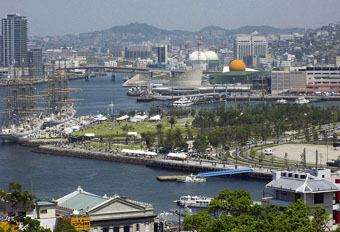


(Wikipedia photo)
Feb. 18 - I have always enjoyed visiting Nagasaki. For me the city's appeal lies in its long history of cultural exchange. As someone who has spent a career trying to facilitate cross-cultural understanding and communication, I feel an affinity to the many Japanese in the 18th and 19th centuries who explained Dutch and Chinese cultures to Japanese government officials.
Since I had not visited Nagasaki in five years, I was delighted to discover a wonderful new addition to this exotic city - The Nagasaki Museum of History and Culture. This museum includes interactive exhibits for children and extensive displays of traditional arts and crafts. I concentrated, however, on exhibits relating to Nagasaki's interaction with outsiders during Japan's period of exclusion.
I learned about the "To-o Tsuji" those interpreter-guides who helped the Chinese businessmen residing in Nagasaki to communicate with Japanese counterparts. A hereditary occupation, these To-o Tsuji looked and acted like Japanese but lived in Chinese-style homes. With a foot in each culture, they served as a bridge between Japan and China. I learned that Japanese would visit the Chinese-style homes of the To-o Tsuji in Nagasaki to learn about China and Chinese culture.
Another display showed that Japan maintained a vibrant trade with Korea through the island of Tsushima. Amenomori Houshu, a Confucian scholar, handled negotiations between Japan and Korea during this period. He believed strongly in telling the truth and treating both sides fairly. It was interesting to learn that long before Japan had a Foreign Ministry, many Japanese served their country as able diplomats.
Until next time,
Jim
Comments Welcome!